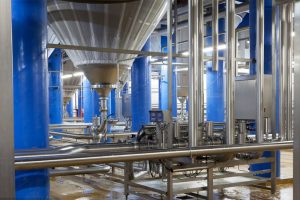
3000L beer brewing equipment is ready
This is a 3000L beer brewing equipment made by Micet craft for a Canadian customer. Made of 304 stainless steel, beautiful and generous. Customers are surprised and satisfied. Micet adheres to the concept of quality-oriented and provides high-quality equipment for everyone. Previous Next Here are some important configurations: 1000kg/h Grain transfer auger(CUL certified) 3000L 2 vessels

How Malt Used in Brewing Equipment Affects Beer
Grains are essential when brewing beer. Grains are used to produce malt for brewing beer. Craft beer equipment requires a wealth of raw materials, many of which are malt. Malt plays a wonderful role in the making of beer. Through a certain process, it can be fermented by yeast, so that it can be made

The Importance of Piping in a Brewery System
If the brewing system is the heart of the brewery, and the artistic interpretation of the mash is the brain and soul, then the plumbing is the nervous system – making sure that messages are passed from one person to another. The glycol piping is part of the glycol chiller. It acts on cold glycol

How to use the by-products in the beer brewing process?
Among the processes involved in brewing beer, these processes generate a large number of by-products. The main brewing industry wastes include brewer’s spent grains, hot residue and carbon dioxide. Proper disposal of these wastes brings economic benefits and helps protect the environment from pollution caused by their excessive accumulation.Although studies have shown that beer contains

Canada 25bbl brewing equipment
The commercial brewing 25BBL complete brewing system has reached Canada. Build a large brewery in Canada to brew delicious beer. Micet craft adheres to the principle of quality-oriented and service-oriented, and has been well received by customers. Customers praised the amazing technology of micet craft engineers and recommend to cooperate with us. brewhouse system 25BBL

kombucha making process
Kombucha, a fermented beverage made from sweetened tea, dates back thousands of years and spreads across China, Japan, and Tibet. Its popularity spread across Russia, then the US, and is now becoming more common in the UK. what is kombucha While mainstream fizzy drinks are often a mix of sugar, carbonated water, and artificial flavors,

How to Create a Proactive Brewery Maintenance Program
Whether it is home brewing or commercial brewing, if you want to brew delicious beer, you must pay attention to the above problems. It is also necessary to be familiar with the beer fermentation and brewing process as much as possible. If you want to have your brewery, you can contact micet craft. We will

The 1000L brewing system was shipped to France
The French 1000L brewing equipment is completed and will be shipped to the local area soon. The equipment was used in a local beer brewing factory, and they introduced a new set of equipment to expand the scale. Better brews great beer. Customers have made good comments on micet craft through pictures and videos, thank

6 key points for successful beer fermentation
Today Micet Craft will discuss with you the important points when fermenting beer. The type of yeast we choose to use, the concentration of wort to ferment, whether commercial beer brewing or home brewing and the final alcohol concentration we expect to achieve all affect the beer fermentation process. Table Of Contents brewing nature Why

2000L brewing equipment shipped to Georgia
The complete 2000L beer brewing equipment was shipped to Georgia. The brewing equipment is customized according to the customer’s requirements, and the customer is very satisfied. The commercial brewing equipment was completed in the stipulated time. Micet craft adheres to the spirit of craftsmanship, and has won the trust of customers with its excellent product
Learn more about winemaking
If you want to learn more about winemaking, you can subscribe to our blog for updates. We will update the blog every week so that you can learn more about winemaking.
